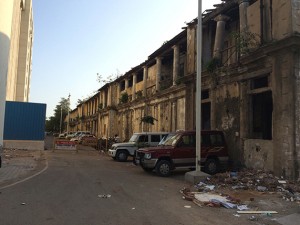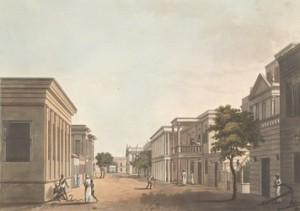Registered with the Registrar of Newspapers for India under R.N.I 53640/91
Vol. XXV No. 21, February 16-29, 2016
Know your Fort better
by Sriram V.
 Middle aka North Street.
Middle aka North Street.
St George’s Street leads you from the eponymous gate to Parade Square. We have already seen the important thoroughfares on the southern side of the Fort, namely St Thomas, Charles, Palace and Church Streets. Now it is time to examine those on the northern side. Of these there are four – Choultry Street is the westernmost, following which is Middle Street. You have two minor thoroughfares – James and Gloucester Streets – close to the eastern end of the Fort but of these there is not much history.
The Choultry Street once led to an eponymous gate on the northern wall of the Fort. This was bricked up by the French in 1746 and for some reason was never opened again.
Both gate and street got their name from the fact that they led directly to the Native Court, or Choultry, that stood just outside the Fort proper. Likewise, the Middle Street got its name because it ends at the Middle Gate of the Fort, which post-1749, by way of being the only opening on the northern side, also came to be referred to as the North Gate. In terms of appearance it is the most formidable among the entrances, tall and gloomy, with a strangely Assyrian aspect to its construction – the rectangular arch and the sloping buttresses giving you that feeling. Sadly, it is also now the worst maintained. A makeshift bazaar comes up each afternoon in the street (right inside what is supposed to be high security premises) with hawkers selling flowers, fruits and stainless steel vessels. The Government employees in the Fort make sure that business thrives.
 View of North Street by Francis S. Ward.
View of North Street by Francis S. Ward.
That both Choultry and Middle Gates were in existence from almost the inception of the Fort is evident from Charles Lockyer’s description of the precinct dating to 1711. He lists five points of ingress to the Fort – Sea, St Thomas, Water (today we take this to be synonymous with the Sea Gate but evidently this was a different entrance then), Choultry and Middle Gates. Of these he notes that St Thomas and Choultry gates were to be opened for passengers at any time of night ‘if unsuspected’ but the others were closed at 6.00 pm.
Of the two, the now lost Choultry Gate was perhaps the older for we do know that the Choultry Court, the first institution to dispense justice to the natives of Madras, was established in 1640. Though this was to be steadily superseded by the Mayor’s Court, the Court of Admiralty and the Court of Judicature, it had a long life, lasting well into the 1700s. Those who sat in judgement were essentially magistrates and the senior-most among them was called the Chief Justice. The judges were designated Judge-Advocate. Besides there was a Town Clerk who maintained the records and also functioned as a Notary Public. The Choultry Court exercised jurisdiction over small causes, customs, sale of property and the registration of slaves.
Successive Governors of Madras pondered over whether it needed to be presided over by an Indian or one of their own countrymen. We do know that the first magistrate was Kannappa, the Adigar or headman of Black Town. Later, such worthies as Kasi Viranna also sat in judgement over here. As Fanny Penny wrote rather mockingly in her account, “they unhesitatingly gave their judgement without the aid of a lawyer, barrister or jury”.
That was not the only connect that this street had with the law. In the 1790s, the Courts of Judicature that initially functioned from Charles Street moved to Choultry Gate Street, which became renamed as Court House Street. In the beginning of the 19th Century, when the Supreme Court was formed, it too operated from the “old Court House much undermined by bandicoots” before it moved in 1817 to First Line Beach. The first Town Hall of Madras was also at Choultry Gate Street and it was from here that in 1688 it moved to St Thomas Street.
Among the most famous residents of Choultry Street was Coja Petrus Uscan, the famed Armenian who gave our city the Marmalong Bridge, the steps to St Thomas’ Mount and the St Mathias Church at Vepery. He was in many ways indispensable to the British and was among the few Armenians who were allowed to live within the Fort. In 1749, when the English returned to Fort St George after the French left, Coja Petrus was in even greater favour for he had defied the erstwhile conquerors right through. He became the only non-Englishman to retain his house within the Fort even as every other property was confiscated. Till the 1770s, long after he was dead, Fort consultations referred to the “house belonging to the Estate of the said Petrus situate on Choultry Gate Street.” Today, it is impossible to see any house on this thoroughfare, for it is completely dominated by the King’s Barracks.
Interestingly, this corner of the Fort may have been witness to perhaps the first instance in Madras of someone in power appropriating public space for personal use. Agent Edward Winter built his house on Middle Street and this was to serve for long as the Governor’s residence, till Fort House was put in good order by Nathaniel Higginson in the 1690s. But Winter also managed to encroach quite a bit. Fort St George consultation books of March 16 and 17, 1674 record that it was ‘resolved also that y’ streete betweene Middle & the Choultry Gate which Sir Edward Winter in his Agency walled up and appropriated to his own use, be againe opened and the wall thrown downe, it appearing by certificates that it hath been a free streete, and of great use…’ This would appear to be the connecting passageway between the two streets at their northern end and it still exists though rather shabbily maintained.
Middle Street was a prominent thoroughfare as long as the Governor lived there. Elihu Yale was perhaps its best known resident and it is relevant to point out that one of his two female associates, Catherine Nicks – lived immediately to the rear, on Choultry Street. The other woman companion, Hieronima de Paivia, the widow of a prominent Portuguese Jew who traded in diamonds, lived in Gloucester Street, the lane that flanks Middle Street on the other side! The area immediately outside the Middle/North Gate was what is intriguingly referred to in the records as a ‘watering place’, the meaning of which is not clear. It would appear to have been deep enough to receive vessels of some kind for on December 29, 1808, this was where Sir George Barlow disembarked to take over as Governor of Madras.
Most fascinatingly, this was also the gate where the Pidari Amman was brought all the way from Black Town each year during the month of Chithirai. The Goddess was of such importance that the Collector of Madras would wait on Her and offer a gold bottu or thali (symbol of marriage) and a red silk saree. This celebration was of sufficient antiquity for the Government to revive it in 1828 at its own expense when the hereditary trustees failed to continue the practice. It is not clear when the tradition was given up.
On a more down to earth note, the first drainpipes of the Fort were laid here and these took the sewage all the way to Royapuram. The Army canteen, which is now a part of the King’s Barracks building, now stretches right across the western side of North Street. On the eastern side is what can only be termed a desecration of Fort St George – the Namakkal Kavignar Maligai. This multi-storeyed structure that ought never to have been built within the Fort, houses several Government departments. However, its story or, more importantly, the history of the space on which it stands needs to be told. More on that next fortnight.

